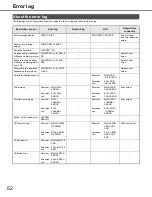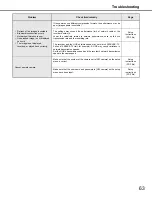
Glossary
66
IP Masquerading
A technology for sharing a single global address between two or
more PCs. Allows simultaneous connection of multiple machines to
1 global address to dynamically convert NAT and different TCP/UDP
port numbers.
IP address
The identification number assigned to PCs connected via IP
networks such as the Internet or an Intranet, or to individual
communications devices. Do not assign the same address to
multiple devices, especially on the Internet.
Internet
PC network that connects networks all over the world. Different
types of PCs can communicate over the Internet.
LAN
A communications network for connecting PCs, printers and other
network devices in a relatively small area such as in a building or
floor of a building or campus in which data is transferred.
M-JPEG
Video format in which the camera sends continuous JPEG images.
Compared with sending images from the camera one at a time, this
method reduces the load on the network. However, the transfer rate
may change depending on the status of the camera. Images may be
represented as a JPEG depending on the camera.
MAC address
Fixed physical address assigned to network devices. Devices send
and receive data based on this.
Manual recording
Click the [Recording] button and the [Recording stop] button to
manually start and stop recording of video and audio.
Multicast
A way to send the same data to multiple users specified on a
network.
Multiscreen Display
This recorder can display multiple camera channels simultaneously
while displaying live images or playback images.
NAT (Network Address Translation)
A technology for sharing a single global address between two or
more PCs.
NTP (Network Time Protocol)
A protocol developed to accurately maintain time among hosts on
the Internet.
POP 3
A protocol for receiving e-mail stored on a server on the Internet or
an Intranet.
POP 3 Server
A server that supports POP3, currently the most widely used mail
sending protocol.
Plug-in Software
Small programs used to add functions to application software.
PoE (Power over Ethernet)
A technique for supplying power and data simultaneously over an
Ethernet cable. PoE was standardized in June, 2003 as
"IEEE802.3af".
PoE Supplied Hub
A switching hub that provides PoE functionality. A maximum of 48 V
15.4 W of power can be supplied to cameras and other devices.
Port Number
A sub address set below the IP address to connect multiple parties
simultaneously for communication (TCP, UDP, etc.) on the Internet.
Primary Server
DNS servers usually have more than 2 system and the primary
server is the main system.
Private Address
IP address assigned when connecting primarily to LAN. Private IP
addresses can be assigned freely on a network and do not require a
formal application. However, because private IP addresses cannot
be used to access the Internet, a router or other device it is
necessary to assign a global IP address.
Protocol
A set of rules that allows the exchange of data amongst different
types PCs with information. The Internet uses the TCP/IP protocol
as its base and information is transferred following http and ftp
protocols depending on the application.
Proxy Server
PC or software that connects with the Internet as the proxy for a
computer on a local network. It allows special connections from the
internal network and blocks unauthorized access from external
networks.
RAID (RAID5)
An abbreviation for Redundant Arrays of Inexpensive Disks 5 that
provides a highly reliable disk array by distributing access over
multiple HDDs, increasing both speed and capacity. Even if one
HDD has errors, data can be recovered based on error correction
data recorded on other HDDs. (RAID5 is used when 3 or more
HDDs are connected. However, when 2 or more HDDs
simultaneously have errors, data cannot be recovered.)
RAID (RAID6)
An abbreviation for Redundant Arrays of Inexpensive Disks 6 that
provides a highly reliable disk array by distributing access over
multiple HDDs, increasing both speed and capacity. Even if two
HDD has errors, data can be recovered based on error correction
data recorded on other HDDs. (RAID6 is used when 4 or more
HDDs are connected. However, when 3 or more HDDs
simultaneously have errors, data cannot be recovered.)
Recording rate (ips, I-Frame)
Unit that determines the smoothness when recorded images are
played back. "ips" indicates the number of recorded frames in 1
second. When the recording rate is higher, the playback is
smoother, but available recording time is reduced. I-Frame indicates
the refresh rate set on the camera.




































